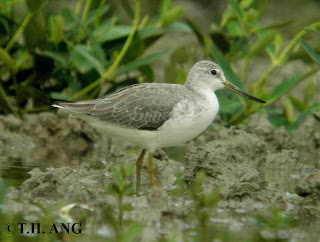
A Nordmann's Greenshank at Sungei Buloh Wetland Reserve, Singapore 15 Nov 2008 (Photo copyright of Mendis Tan)
It has been a historical moment for many birdwatchers in Singapore when 2 Nordmann's Greeshanks turned up unexpectedly at Sungei Buloh Wetlend Reserve on 15 Nov 2008 - after 27 years since it was last reported in Singapore (Nature Society Singapore).
The bird was first discovered by Tan Kok Hui, Danny Lau and Lau Jia Sheng and Tan Gim Cheong. Soon afterwards the ID was confirmed by David Li who has previous experience with the species in Malaysia.
Nordmann's Greenshank is an Endangered species according to BirdLife International where its migratory routes are confined to East Asian Australasian Flyway. Its global population is very low and is estimated at less than 1000 individuals. There has been many encouraging sighting of Nordmann's Greenshanks lately, many from the sites where this species was never officially reported previously, such as Sumatra, Java and NW Australia.

RIGHT: One of two Nordmann's Greenshank found strutting on the muds in Singapore. An inconspicuous rarity that has caused much excitement among local and international birdwatchers. (Photo Copyright: Howard Banwell 2008)
However, this sighting in Singapore is signficant and unique because the birds were located within a nature reserve and have been observed feeding actively on the site. The combination of easy accessibility with hides as well as good number of local experienced birdwathcers and photographers mean that this is a rare opportunity to better study Nordmann's Greenshank's feeding and movement behaviour. 
LEFT: A Nordmann's Greenshank showing its unique semi-webbed feet. (Photo Copyright: LIM Kim Chual 2008)

RIGHT: A Nordmann's Greenshank feeding on a crab. If you know the species of the crab, pls let me know copsychus at gmail dot com
Well done to those who had discovered this little known and easily overlooked shorebird!!
Hope the birds will hang around a bit longer so that every birder in Singapore or visiting international birder will have a Christmas Gift!!















